New Chromatography Columns and Accessories at Pittcon 2014 (Part 1)
LCGC Europe
Part 1 of our annual report on new products introduced at Pittcon. This month, columns are highlighted, covering HPLC/UHPLC columns, packings, and related products.
Part 1 of our yearly report on new products introduced at Pittcon. This month, columns are highlighted, and high performance liquid chromatography (HPLC) and ultrahigh-pressure liquid chromatography (UHPLC) columns, packings, and related products are covered.
Pittcon 2014 Conference and Expo (less formally known as the 65th Pittsburgh Conference on Analytical Chemistry and Applied Spectroscopy) was held once again in the gigantic McCormick Place in Chicago, Illinois, USA, on 2–6 March 2014. This year's event hosted more than 900 instrument manufacturers and laboratory suppliers in more than 1900 booths. In addition to attending the exposition, the conferees listened to more than 2000 technical presentations (orals, posters, workshops, invited and contributed talks, and award symposia), checked on numerous company seminar rooms, or attended one of 116 short courses.
Pittcon remains one of the most important international analytical exhibitions where companies introduce their latest instruments, instrument accessories, software, columns, sample preparation, and other consumable products. Several notable companies were missing again this year, but enough were present such that visitors had plenty of opportunities to investigate new, improved, and old technologies.
The purpose of this report is to provide information about many of the new separation consumables and accessory products that were displayed at Pittcon 2014. In some cases, products that were introduced during 2013 but after Pittcon 2013 (1,2) may be included for reasons of completeness. The information is based on manufacturers' responses to a questionnaire mailed in early 2014. Because of space limitations and the fact that some manufacturers did not respond to the questionnaire, this report cannot be considered an exhaustive listing of all new products that were introduced in Chicago. However, over the years, these Pittcon introduction summaries have provided a good source of information that would be difficult for one individual to gather during the four days of the exhibition. In addition, the products introduced have shown definite correlations to current research, development, and application activity in the separation sciences.
As in previous years, columns and other products recommended by their manufacturers primarily for biomolecule separations or sample preparation are denoted in the tables with the designation BIO. Some of these products may be used for general high performance liquid chromatography (HPLC) separations and for sample preparation as well, but their main emphasis is for biological samples.
In this month's coverage, I will describe new introductions in the areas of HPLC columns for reversed-phase LC, hydrophilic-interaction chromatography (HILIC), ion-exchange and ion chromatography, and size-exclusion chromatography (SEC). Specialty columns for specific types of analyses are also covered. Next month, I will look at gas chromatography (GC) and supercritical fluid chromatography (SFC) columns, sample preparation products, and hardware, accessories and small tabletop instruments, mainly for sample preparation.
Trends and Highlights for Pittcon 2014
General: Although Pittcon is not considered to be a life science–oriented exhibition, this year I observed an increasing interest in the separation and sample preparation of biological compounds including proteins — especially monoclonal antibodies (mAbs) — peptides, glycans, and biological fluids. Food analysis is still getting lots of attention with specialty products for extractions of pesticides and mycotoxins. Ultrahigh-pressure liquid chromatography (UHPLC) is getting more attention in the hardware area where new injectors, tubing, and fittings are offered that will take pressures up to 20,000 psi. Again at Pittcon this year, I saw a considerable number of new accessories, hardware, and devices designed to make the chromatographic laboratory more productive.
HPLC Columns: Overall, superficially porous (core–shell) particles (SPPs) attracted the most attention with new companies coming into the technology and older companies with existing products filling out their portfolio with more phases. It was almost as if the sub-2-μm porous particles that spawned UHPLC have been pushed to the side and core–shell columns are now expanding into larger particle sizes and even into preparative LC. This year, the introduction of new HILIC columns slowed down a bit, but alternative reversed-phase selectivities, especially phenyl-hexyl and fluoro phases, were evident. Still, in the number of introductions, reversed-phase HPLC maintained its dominance. Application-wise, chiral, protein (particularly monoclonal antibody columns), and ion chromatography and ion-exchange columns dominated. Some interesting size-exclusion columns for high-temperature separations, the resolution of monoclonal antibody fragments and aggregates, and mixed-mode SEC were shown.
Gas Chromatography: GC column introductions were the fewest in a number of years with only two companies providing information on their new columns. Specialty columns giving nice separations of sulphur-containing compounds and European Union (EU) and United States Environmental Protection Agency (US EPA) polycyclic aromatic hydrocarbons (PAHs) were shown. On the hardware side, a self-adjusting column nut solves the age-old problem of having to continually retighten column graphite ferrules after repeated temperature programming cycles.
Sample Preparation: Sample preparation products for automation, such as 48- and 96-well filtration, solid-phase extraction (SPE) plates and plate seals, and SPE micropipette-tips, seemed to be in vogue. Because of the popularity of protein-crash approaches for the analysis of drugs and metabolites in biological fluids, additional plates designed to remove both precipitated protein and also phospholipids, with proprietary phosphorous selective phases, were introduced. SPE phases for mycotoxin removal not involving expensive immunoaffinity phases were noted. QuEChERS (quick, easy, cheap, effective, rugged, and safe) is still "catching" on as the favoured sample preparation technique for pesticides in fruits and vegetables, but it has expanded well beyond that application area into biological fluids, environmental samples, meats, and other matrices. A new sorbent to replace the problematic graphitized carbon black in dispersive SPE (dSPE) was shown as well as a series of standards for pesticides.
Accessories: More than 30 new hardware products, accessories, and benchtop instruments for LC, GC, and sample preparation were noted. This year I separated the hardware and accessories introductions from the benchtop instrumental introductions into two separate tables. UHPLC-specific products (tubing, fittings, column hardware, injectors, and PEEK fittings) with higher-pressure ratings and decreased dead volumes were introduced. A number of sample preparation automated instruments contribute to minimize the labour-intensiveness and drudgery of manually preparing samples for chromatography were introduced by smaller instrument vendors. Products for preparing solid materials for further workup, such as homogenizers, shakers, grinders, milling devices, and solvent evaporation stations will also be covered. These products will be discussed next month in part 2 of the Pittcon report.
New Series of HPLC Columns and Packings
Each year manufacturers introduce entire new families of HPLC columns at Pittcon 2014. For the sake of brevity, I have elected to cover those series here instead of listing each column under individual headings in the modes' tables. In some cases, the series are extensions of existing products but covering additional phases, while in other cases the families are entirely new to the market.
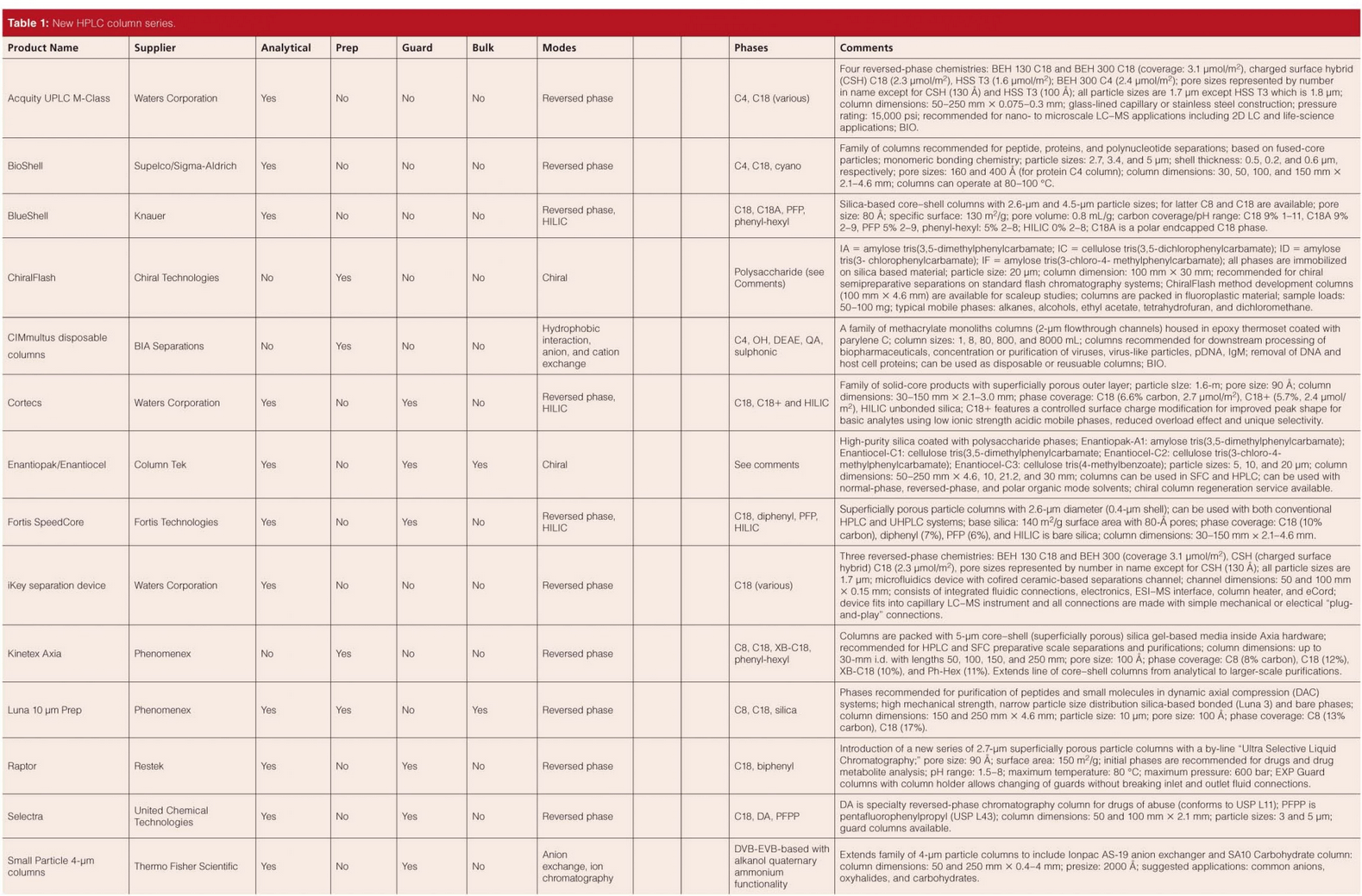
Table 1: New HPLC column series.
New series of HPLC columns were shown by 10 companies (Table 1). By far, the largest number of introductions were for new (or extended) families of SPP columns. It seems most of the action is taking place in this area with introductions of new sub-2-μm columns reduced compared to previous years. Companies with SPP columns are now filling out their product lines with a wider variety of reversed phases (beyond the C8 and C18 phases) and HILIC phases as well. One of the newest entries in the SPP race are the SpeedCore columns from Fortis Technologies, a small British company specializing in HPLC columns. Figure 1 shows the separation of the US EPA 16 polynuclear aromatic hydrocarbon standards on a set of three columns with different particle sizes. It demonstrates the advantage of using a 2.7-μm solid-core reversed-phase column versus totally porous 3- and 5-μm dp reversed-phase columns under the same gradient conditions and same column geometry. With its slightly smaller particle size, the 2.7-μm SPP column gave a slightly increased pressure drop over the 3-μm column. Of course, with the increased resolution of the SPP column, an even shorter one would have resulted in a faster separation with equal to or better resolution than a porous particle column and a lower pressure drop. It is no wonder that users are quickly gravitating to the SPP columns for their analytical work.
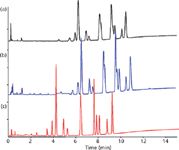
Figure 1: Comparing 2.6-μm superficially porous particle column separation with 3- and 5-μm totally porous particles under gradient conditions: (a) 5-μm Fortis C18, (b) 3-μm Fortis C18, and (c) 2.6-μm SpeedCore C18. Column dimensions: 50 mm à 3 mm; mobile phase: 50â100% acetonitrile in 10 min; hold 15 min; flow rate: 0.6 mL/min; detection: 254 nm; sample: 16 US EPA PAH standards. (Courtesy of Fortis Technologies.)
The first SPPs were in the 2.6–2.7 μm range, but last year a number of SPP companies went to larger particles all the way up to 5 μm. A 5-μm SPP gives the same efficiency as a 3-μm porous particle, but the pressure drop is dramatically lower than the 3-μm column (of the same dimensions) and equivalent to a 5-μm porous particle column. This year, Phenomenex has packed their 5-μm SPP particles into preparative columns to extend the line from analytical- to larger-scale purifications.
Don't count out the small porous particles just yet. Because many laboratories have already invested in UHPLC systems, column manufacturers continue to introduce smaller porous particle versions of their popular series. With a wide range of particle sizes (made by the same process and chemistry) from UHPLC to preparative, seamless scaleup and scaledown within a family is possible. Method development can be performed on a short, fast analytical column and then can be scaled up to preparative dimensions with easy method transfer. For polymeric columns, smaller particle sizes have also been introduced, thereby allowing for increased efficiency and operation at high pH and high temperature, a big plus over silica gel-based columns. An example shown in Figure 2 is the 4-μm Carbopac SA10 column from Thermo Fisher Scientific (formerly Dionex). The column has an ethylvinylbenzene–divinylbenzene (DVB) composition and difunctional quaternary ammonium surface groups; thus, it is an anion-exchange column. It is recommended for the separation of mono- and di-saccharide analysis using pulsed amperometric detection. Available in 2- and 4-mm internal diameters, the column can separate biofuel sugars, food sugars, and high-concentration sugar solutions in a matter of minutes. Figure 2 shows the fast separation of biofuel sugars on a 250 mm × 2 mm column using a 1 M KOH eluent in just under 6 min. Under these conditions, the sugars are ionized and therefore can be separated by anion-exchange interactions. The pressure drop on this isocratic run was 2160 psi, well within the capability of HPLC instruments.
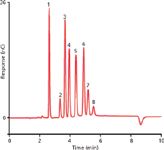
Figure 2: Fast separation of biofuel sugars on the 4-μm CarboPac SA-10 anion-exchange column. Column: Dionex CarboPac SA10-4 μm, 2 mm; eluent: 1 mM potassium hydroxide; eluent source: Dionex EGC 500 KOH cartridge; flow rate: 0.38 mL/min; injection volume: 2.5 μL; temperature: 45 °C; detection: integrated amperometry, quadruple pulse waveform; working electrode: PTFE Gold, disposable electrode; reference electrode: silver, silver chloride; standard concentration: 10 mg/L. Peaks: 1 = fucose, 2 = sucrose, 3 = arabinose, 4 = galactose, 5 = glucose, 6 = xylose, 7 = mannose, 8 = fructose. (Courtesy of Thermo Fisher Scientific.)
Immobilized polysaccharide–based chiral columns made their appearance a few years ago. Compared to coated phases, these columns are more forgiving for solvent changeover and allow more flexibility in choosing solvent mixtures. Chiral Technologies, a company under the Daicel umbrella, extended its line of immobilized polysaccharide phases to preparative dimensions.
Usually LC columns are not considered to be disposable, but when working in the downstream processing of high-priced, high-potency biopharmaceutical materials where viruses or possible biocontaminants may be present, the idea may be worthy of consideration. BIA Separations, known in the bioprocessing area, have now packed their columns in plastic housings that are considered disposable. However, like any LC column, they can be used repeatedly for normal separations.
Reversed-Phase Chromatography
As is usual, many new reversed-phase chromatography columns were introduced at Pittcon 2014 (see Table 2). If one also adds all the columns capable of reversed-phase interactions covered in the new series (Table 1) and in specialty columns (Table 3), you can clearly see the dominance of this operational mode. This year's Pittcon added more than 50 new reversed-phase columns to the huge number that already exist from past introductions. Silica-based bonded phase columns dominated the introductions again this year (~95%), but four organic-silica hybrids were also on the scene.
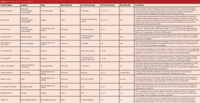
Table 2: Reversed-phase chromatography.
The C18 (octadecylsilane) functionality proved to be the the most popular again this year with nearly 50% of all reversed-phase column introductions being this alkyl phase. However, this phase isn't always the optimum choice for all separations and a great number of other hydrophobic stationary phases were introduced. Besides the normal C4 and C8 phases, C18 with mixed functionality (mixed mode), phenyl-hexyl, diphenyl, embedded polar, pentafluorophenyl (PFP), and cyanopropyl phases were made available by various suppliers to present selectivity alternatives. One new polymer-based phase was shown at Pittcon. The HILIC columns that have some hydrophobic interaction possibilities are found later in this report.
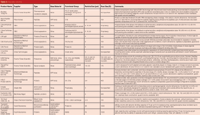
Table 3: Specialty columns.
A total of five perfluorinated phase columns were introduced this year. The most popular chemistry is the pentaflourophenyl phase bound to a silica surface. This phase provides a unique aromatic selectivity because of highly electronegative fluorine atoms on the periphery of the phenyl ring ligand. It is recommended for the separation of aromatic and halogenated compounds and offers quite a different selectivity compared to C8 and C18 columns. Other fluoro-phases introduced had alkyl perflourinated and fluorophenyl bonding.
In recent years, there has been a trend in introductions of bonded silica-based columns with wider pH limits. Most bonded-phase silicas are recommended to be used in the 2–8 pH range. At low pH (<2), the bonded phase, especially those with short chain lengths, will hydrolyze and leave behind bare silica. Consequently, retention times will generally change and peak tailing becomes a big problem. At high pH (>8), the silica gel itself will begin to solubilize, a process that is dependent on the solvent, type of buffer, and temperature. By bonding carbon phases with sterically protecting groups, with high coverage of long alkyl groups, or by coating the silica with polymeric material, the lower pH range can be extended. By using organo-silica hybrid chemistry, bidentate bonding, and polymer-coatings or polymer-encapsulation, the range can be further extended. Advanced Chromatography Technologies introduced C18 and phenyl-hexyl columns with encapsulated bonding technology that offer a pH range of 1.5–11, well beyond the high-pH capability of most reversed-phase materials. This year the winner in the high-pH battle, though, was the Diamond columns from Diamond Analytics. The company's mixed-mode C18-WAX phase could be used at pH values as high as pH 13 with a 100 °C temperature limit.
An interesting new type of column was introduced by Supelco/Sigma Aldrich as its Titan line. Because some attribute the narrow particle size distribution of SPPs and the more homogenous packing density that occurs as one of the reasons that there is a significant efficiency gain for the larger particles, Supelco chemists developed a monodisperse sub-2-μm silica base material that showed excellent efficiency but because of its narrow particle size gave lower pressure drop than broader particle size distributions typical of the smaller porous particles.
Hydrophilic Interaction Liquid Chromatography
After several years of numerous HILIC column introductions, Pittcon 2014 saw only a few new HILIC columns. Although three new HILIC columns were covered in the new series listings of Table 1, all were bare silica. Three additional columns categorized as HILIC columns are covered here. The Waters XBridge Glycan BEH Amide column is based on ethylene bridged hybrid (BEH) column particle technology with optimized amide-bonded ligands (phase coverage: 7.5 μmol/m2). New 2.5- and 3.5-μm particle sizes contain the same separation chemistry as the existing 1.7-μm version but were introduced for those laboratories looking for flexibility during method development or a means of transferring separations methods between UHPLC and HPLC instrumentation. The pore size of 130 Å is ideal for the LC and LC–MS analysis of fluorescently labelled, released N-linked glycans. The columns are quality controlled with 2-AB–labelled glycans derived from human mAb IgG to ensure that the columns are consistent for validated methods. Stainless steel column dimensions cover the range of 50–150 mm × 2.1–4.6 mm; guard columns are available. ChromaNik Technologies also introduced SunShell HILIC-Amide chemistry. Compared to other HILIC phases, this SPP-based 2.6-μm particle has a very high hydrophobicity, as evidenced by its high retention factor for uridine.

Figure 3: Separation of 2-aminobenzamideâlabelled glycan performance test standard on a glycan specialty column. Column: 150 mm à 2.1 mm, 1.7-μm dp Acquity UPLC BEH Glycan; mobile-phase A: 100 mM ammonium formate, pH 4.4; mobile-phase B: acetonitrile; mobile-phase gradient: 78â55.9% B in 38.5 min; flow rate: 0.50 mL/min; pressure: 8700 psi; sample injection: 3 pmol in 2.5 μL. (Courtesy of Waters Corp.)
The third HILIC column is a quite different chemistry. The ES Industries FluoroSep HILIC has a fluorinated diol phase and is recommended for the retention and separation of highly polar halogenated compounds. Columns with particle diameters ranging from 1.8 to 20 μm are available in a wide variety of column hardware (stainless steel or PEEK construction) with dimensions ranging from nanoscale to preparative. Guard columns, cartridge designs, and bulk packing can be purchased from ES Industries.
Size-Exclusion Chromatography
In the past few years, only a few new SEC columns have been introduced at Pittcon. That doesn't mean that SEC is not a highly practiced separation mode. It is a standard technique for the separation and characterization of organic polymers, both organic- and water-soluble. In addition, the mode is widely used for the separation of proteins and other biopolymers, sometimes known as gel filtration chromatography. Only two companies (Tosoh Bioscience and Separations Methods Technologies [SMT]) introduced columns for SEC at Pittcon 2014. Both aqueous-compatible columns for biomolecules and organic-compatible columns were introduced. The SMT columns actually involve mixed mechanisms and therefore aren't strictly SEC columns.
The Tosoh TSKgel SuperSW mAb columns contain aqueous-compatible, 4-μm silica-based particles that are recommended for the high-resolution and high-speed separation of monoclonal antibody fragments, monomer and dimer. With a 250-Å pore size, the operating range stretches from 10,000 Da to 500,000 Da (globular protein calibration). There are two types of columns. One is termed the SuperSW mAb HR (High Resolution) column whose dimensions are 300 mm × 7.8 mm; a matching HR guard column has a narrower internal diameter (6.0 mm) and shorter length (40 mm). The second column in the family is the SuperSW mAb HTP (High Throughput) column whose dimensions are 150 mm × 14.6 mm; a matching HR guard column has a narrower internal diameter (3.0 mm) and shorter length (20 mm). The high-resolution capability of the column results from a pore-controlled technology that produces a shallow calibration curve in the molecular weight region of a typical monoclonal antibody. Both columns are usable with HPLC and UHPLC systems because of their ability to withstand high flow rates with moderate pressure drops.
A larger pore size (300 Å) version called the TSKgel UltraSW Aggregate is also useful in monoclonal antibody purification and analysis. Also a 4-μm silica-based packing, this column covers the range of 10,000–2,000,000 Da (globular proteins) and has dimensions of 300 mm × 7.8 mm; a matching 40 mm × 6.0 mmguard column is available. As implied by its name, this column is used for the high resolution analysis of higher order mAb aggregates. The larger exclusion limit of this column allows resolving power for multimers and aggregates of large proteins, including thyroglobulin and IgG.
A third type of SEC column for gel permeation chromatography (GPC) was also introduced by Tosoh. The TSKgel Ultra-High Temperature columns are designed for the analysis of organic-soluble polymers at extremely high temperatures. These columns are for applications up to 220 °C and are shipped in o-dichlorobenzene (ODCB), which can be exchanged for 1-chloronaphthalene and trichlorobenzene. These TSKgel columns are mixed-bed columns packed with particles of different pore sizes that are blended to provide an extended calibration curve. Mixed-bed columns are used when a broad range of polymer molar masses are expected in the sample. The TSKgel High Temperature columns are suitable for applications up to 140 °C. The exclusion limit for most of the high-temperature mixed bed columns is 4.0 × 108 Da. Other high temperature columns are also available with different limits.
The SMT columns that were shown at Pittcon 2014 were the company's SMTgel line of 5-μm silica-based particles with different pore sizes: 300, 1000, and 2000 Å. Instead of being deactivated with aqueous compatible phases such as diol, these columns have nonpolar ligands that make them also display reversed-phase properties. In fact, the columns have four different nonpolar modifications, termed RP1, RP2, RP3, and RP4, which have increasing nonpolar characteristics. Thus, the RP1 column has the most "polar" behaviour. The columns are used with solvents such as acetonitrile and water or methanol–water, but they can also be used for GPC with common organic solvents like toluene. Thus, these column can also display some normal phase characteristics. Being silica-based, these columns do not shrink or swell with changes over a wide spectrum of solvents. With the varying pore sizes, the SMTgel columns can accommodate various sizes of molecules including oligomers and polymers. Typical column dimensions displayed were 300 mm × 7.8 mm and 300 mm × 10 mm. Guard columns, cartridge hardware, and bulk packing can also be purchased from SMT. Columns are housed in stainless steel and PEEK.
Ion-Exchange and Ion Chromatography
Ion-exchange and ion chromatography are interchangeable in that they both use the same technology and often the same phases. Besides the ion chromatography (IC) columns shown in Table 1, three companies introduced ion-exchange columns at Pittcon 2014. Showa Denko's product line called Shodex has long been a player in the size-exclusion columns market. This year they showed the Shodex IC YS-50, a polymer-based IC column for monovalent and divalent cation analysis; it possesses a carboxyl functional group. This column (dimensions: 125 mm × 4.6 mm) is compatible with both the suppressed and nonsuppressed versions of IC. The plate number specification of this column is 5500. Some recommended applications include the separation and analysis of alkylamines such as adrenaline, noradrenaline, dopamine, acetylcholine, and choline; transition metals; amino acids; and NH4+ analysis at a high concentration of Na+ (Na+:NH4+ = 5000:1 is possible). Methanesulphonic acid, sulphuric acid, nitric acid, and phosphoric acid are the most popular eluents used with this column.
Silicycle is a Canadian company specializing in silica-based HPLC columns. This year they expanded their line to include the SiliaChrom SCX column. The functional group on this strong cation exchange column is p-toluenesulphonic acid. The column is available in 3-, 5- and 10-μm particle sizes and a wide variety of dimensions ranging from analytical to preparative. Guard columns, cartridge columns, and bulk packing can all be purchased from the company.
YMC USA introduced two ion-exchange hydrophilic polymeric (methacrylic) packings that are sold in bulk, mainly for larger scale purifications of biopharmaceuticals. The BioPro DA packing is a weak anion exchanger with diethylamine groups and the BioPro CM is a weak cation exchanger with carboxymethyl functionality. The spherical particles have a diameter of 60 μm. Method screening columns of 1 mL (26 mm × 7.0 mm) and 5 mL (26 mm × 15.6 mm) volumes are available for developing optimized chromatographic conditions and for laboratory-scale purifications. The polymeric columns show alternative separation characteristics to existing strong ion exchangers. They show high binding capacity and moderate pressure drop. These two new columns join the previously introduced BioProQ and Biopro S, which were strong anion (quaternary amine) and strong cation exchanger (alkylsulphonic acid) columns, respectively. The four phases represent an ion-exchange screening kit for separations of proteins, nucleotides, and other biomolecules.
Specialty HPLC Columns
Specialty columns are HPLC columns that have been developed for specific separations that are difficult to achieve on a standard column. However, sometimes manufacturers will use a standard column but test it specifically for a certain class or compounds and provide a recommended set of chromatographic conditions. In some cases, the specialty column comes as part of a "total solution" kit with reagents, standards, and a method. Most specialty columns will be delivered with a test chromatogram from an analysis performed at the factory before shipment, and some are guaranteed for a specific separation. In addition to the new specialty column families shown in Table 1, Table 3 shows the 17 additional specialty phases that were presented at Pittcon 2014. Silica gel-based columns dominated the introductions, but three polymer-based specialty columns and packings were also introduced. SPP columns are now beginning to be seen in the specialty columns area. First, manufacturers usually extend their lines with the regular phases such as C8, C18, and phenyl, then go to specialty chemistries. Only a scattered number of new HILIC columns were introduced this year. Compared to the last two years, which saw many companies declaring their silica columns as HILIC specialty columns, few new phases other than silica were seen.
As depicted in Table 3, three main application areas dominated the specialty column introductions again this year: Proteins, particularly antibodies; chiral compounds; and peptides. The protein columns were based on multiple separation modes (anion-exchange, reversed-phase, size-exclusion, affinity [protein A and IgG], and mixed mechanisms). For many years, the study of monoclonal antibodies has been a hot area in the potential development of biopharmaceuticals for diagnostics and clinical uses. A number of monoclonal antibody-based drugs have been approved by the U.S. Food and Drug Administration. Thus, columns for monoclonals still make their appearance. Glycan profiles have also gotten attention; a new glycan specific column was introduced by Thermo Fisher Scientific. Thermo also introduced a "top down" proteomics reversed-phase column set, designed to interface directly to the company's mass spectrometric system.
Chiral separations are still in the forefront especially in the pharmaceutical industry. A total of 11 new chiral HPLC columns were introduced at Pittcon 2014 (seven are covered in Table 1 and the rest in Table 3), based on modified cellulose and amylose (polysaccharide) phases, protein phases, and crown ether phases. Immobilized chiral phases seem to be catching on and allow the use of a wider variety of mobile-phase conditions than the coated chiral phases. Because many analytical separations are scaled up to obtain larger quantities of purified enantiomers, preparative particle sizes are frequently part of column introductions, hence some particles as large as 20 μm were displayed.
Peptide mapping is a widely used protein characterization technique in the biopharma industry. Three C18 columns and one C4 phase dedicated to peptide mapping and analysis were introduced with two of them being on the popular SPP base material.
Acknowledgement
I would like to thank the manufacturers and distributors that kindly furnished the requested information in advance of Pittcon 2014, thus allowing a timely report on new product introductions. For those manufacturers who would like to be considered for inclusion into Pittcon 2015 coverage, please send the name of the primary company contact, the mailing address, phone number, and e-mail address to Laura Bush, Editorial Director, LCGC Europe, lbush@advanstar.com, with the subject line "Pittcon 2015 Column Watch".
"Column Watch" Editor Ronald E. Majors is an analytical consultant and is a member of LCGC Europe's editorial advisory board. Direct correspondence about this column should be addressed to "Column Watch", LCGC Europe, 4A Bridgegate Pavilion, Chester Business Park, Wrexham Road, Chester, CH4 9QH, UK, or e-mail the editor-in-chief, Alasdair Matheson, at amatheson@advanstar.com
References
(1) R.E. Majors, LCGC Europe 26(5), 277–291 (2013).
(2) R.E. Majors, LCGC North Am. 32(5), 364–381 (2013).
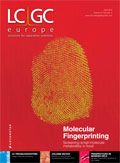
New Study Reviews Chromatography Methods for Flavonoid Analysis
April 21st 2025Flavonoids are widely used metabolites that carry out various functions in different industries, such as food and cosmetics. Detecting, separating, and quantifying them in fruit species can be a complicated process.
Quantifying Terpenes in Hydrodistilled Cannabis sativa Essential Oil with GC-MS
April 21st 2025A recent study conducted at the University of Georgia, (Athens, Georgia) presented a validated method for quantifying 18 terpenes in Cannabis sativa essential oil, extracted via hydrodistillation. The method, utilizing gas chromatography–mass spectrometry (GC–MS) with selected ion monitoring (SIM), includes using internal standards (n-tridecane and octadecane) for accurate analysis, with key validation parameters—such as specificity, accuracy, precision, and detection limits—thoroughly assessed. LCGC International spoke to Noelle Joy of the University of Georgia, corresponding author of this paper discussing the method, about its creation and benefits it offers the analytical community.










